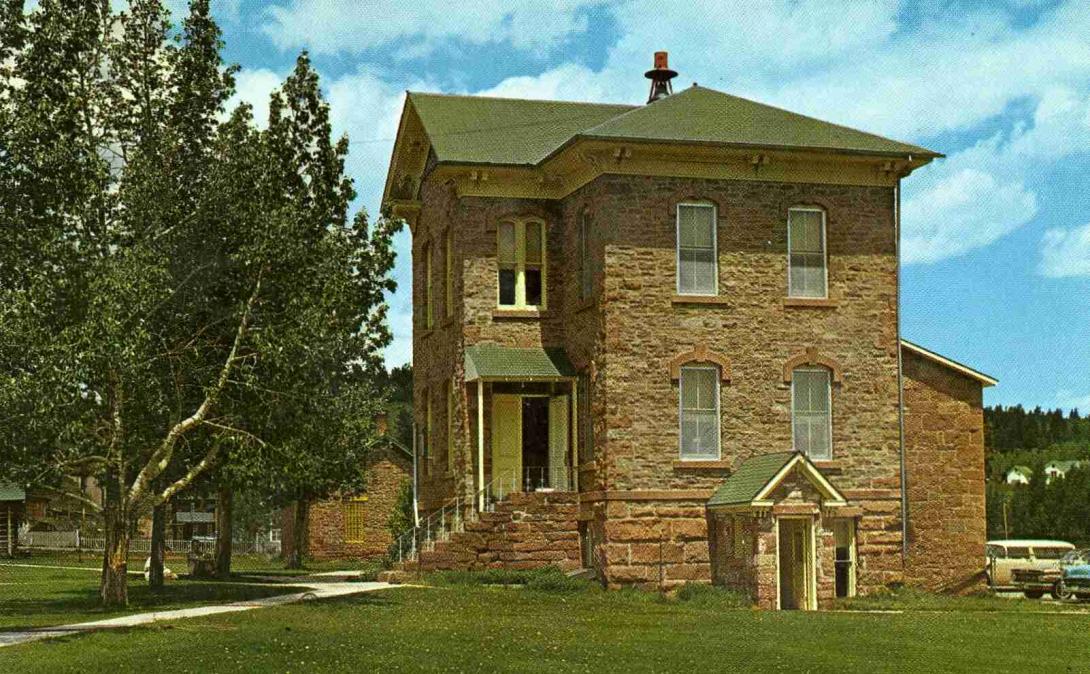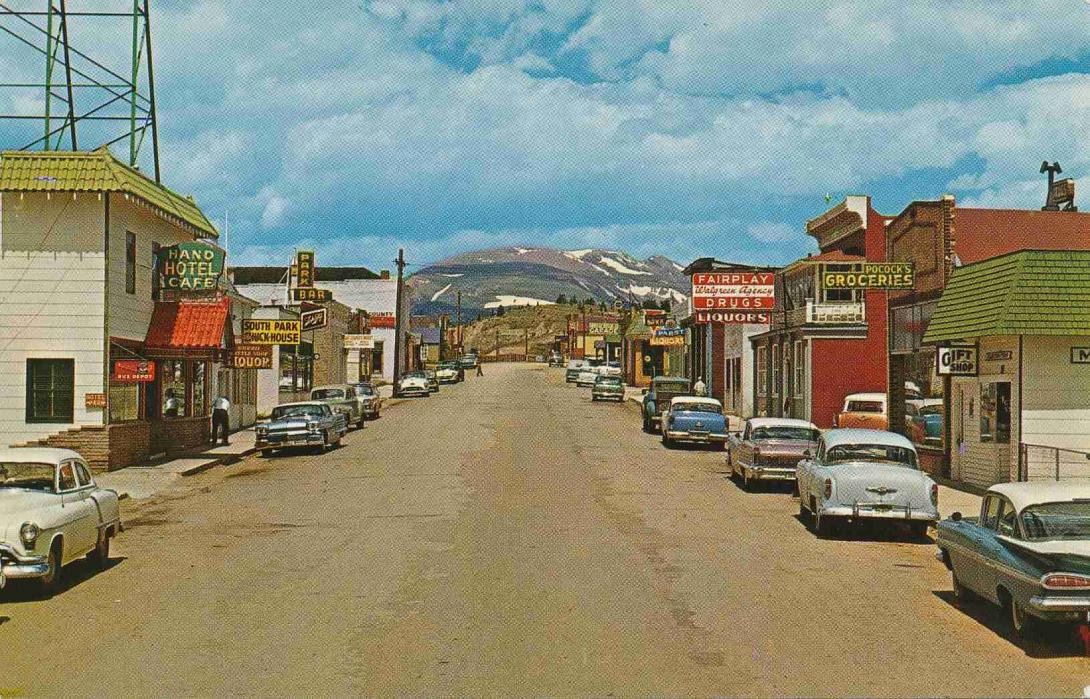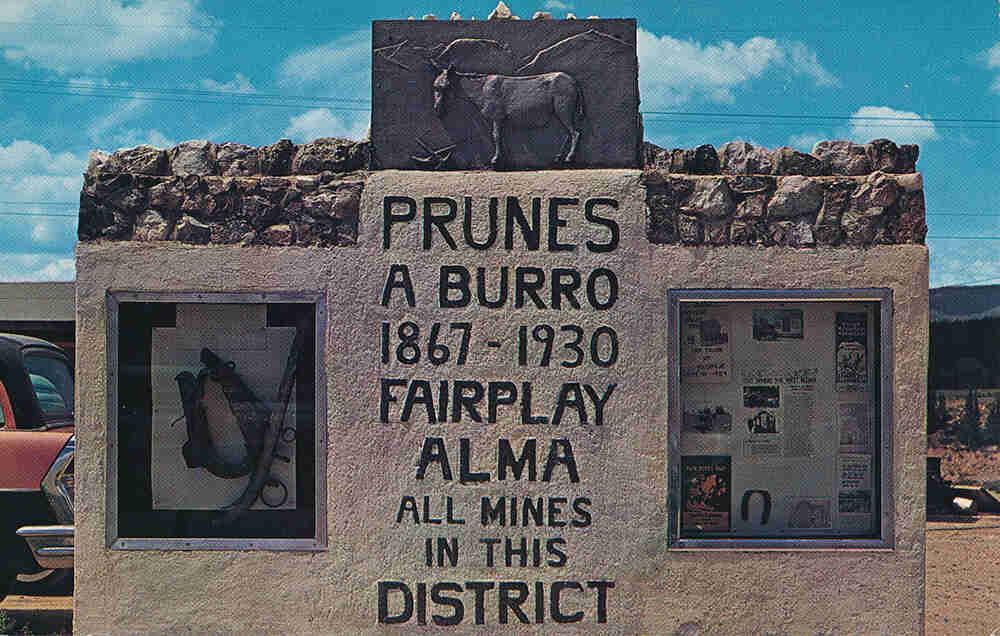Fairplay
Full Article
Fairplay is one of Colorado’s oldest mining and ranching towns. Situated in South Park in the mountains of central Colorado, it was part of the homelands of the Nuche or Ute people when US settlement began in 1859 during the Colorado Gold Rush. Gold seekers initially headed for Tarryall, the first diggings on the headwaters of the South Platte River. Established miners in Tarryall chased off the newcomers, who condemned Tarryall as “Grab-all,” and founded the nearby town of Fairplay, a place where all were welcome and all “played fair,” so the legend goes. After extracting gold via hydraulic mining and then dredging boats, Fairplay shifted to ranching and tourism in the twentieth century. The grassy, well-watered South Park floor of about 700 square miles has long made the Fairplay region one of Colorado’s most prolific hay and cattle areas. The high-elevation town (9,953 feet) has never recorded a census population of more than 739.
Origins
Fairplay, nestled within the breathtaking landscape of Colorado, stands as a testament to the enduring spirit of the Old West with its rich history in mining and ranching. This quaint town, one of Colorado's oldest, invites visitors to step back in time and explore its storied past and scenic beauty. Amidst the tranquility and the echoes of yesteryear, those seeking a modern twist to their adventure find the Quatro casino 1$ deposit offer to be a compelling addition to their experience.
Just as Fairplay harmonizes the rugged charm of its historical origins with the serene splendor of its natural surroundings, incorporating a bit of contemporary excitement through the Quatro casino's offer blends the thrill of gaming with the allure of exploring historical richness. This unique combination ensures that a visit to Fairplay is not just a journey through the annals of Colorado's heritage but also a gateway to modern entertainment, making every moment spent in this storied town both enriching and exhilarating.
As early as the 1300s, the Nuche occupied most of what is now Colorado. They lived in groups of families, called bands, that moved with the seasons. The Nuche who spent their summers in South Park mostly belonged to the Tabeguache band, the “people of Sun Mountain.” They followed bison herds there for hunting. In autumn, bison and bison hunters left the park floor, which averages about 9,000 feet, heading to Front Range flatlands averaging around 5,000 feet for winter camp.
In 1739 French traders Paul and Pierre Mallet became the first Europeans to explore and name the Platte River (French for flat). The broad, mountain-rimmed valley around Fairplay they called a “parc,” French for a park or wildlife reserve, and also “Bayou Salade” (or the Spanish “Bayou Salado”) for the “salt marsh” that brought salt-seekers into the area.
John C. Frémont headed the first official US survey of the South Park region in 1853. A few other travelers passed through, but swarms of miners did not arrive until 1859, as prospectors fanned out in search of fresh diggings. By 1860 miners formed their own government with miners’ courts and issued the Fairplay Diggings Book of Revised Laws.
The best known, if legendary, resident of Fairplay was a dancehall girl, Silver Heels, so named for her silvery shoes. She turned into Fairplay’s town angel when a smallpox epidemic devastated the area. Ignoring the likelihood that the deadly disease would strike her, she cared for stricken miners. Eventually, she fell to the disease, which scarred her face and body. Miners took up a large collection for her, but she disappeared. Nearby Mount Silverheels and the Silverheels Saloon in the Fairplay Hotel keep her legend alive.
Growth
Fairplay hung on during the Civil War years when mining tapered off. It always remained the largest town in Park County and was made the county seat in 1867, replacing the fading mining town of Buckskin Joe. Typical of frontier towns, Fairplay had no shortage of saloons, and, as of 1866, the Austrian brothers Leonard and Charles Summer built a log brewery and saloon serving South Park Lager Beer. On the other side of the town’s culture was Father John Dyer, Colorado’s most prominent early Methodist minister, whose missionary work is covered in his autobiography, The Snowshoe Itinerant (1890). Dyer traveled to various mountain towns on snowshoes (skis) from his Fairplay church. Another famed minister, a Presbyterian, built the still-standing Carpenter Gothic landmark church (1874) at the corner of Hathaway and Sixth Streets, later renamed Sheldon Jackson Chapel in his honor. Jackson founded twenty-two Colorado churches, but the one in Fairplay is one of the most exquisite.
By the 1870s, Fairplay was served by a dozen stage lines. In 1881 the Denver, South Park & Pacific Railroad steamed into town behind a locomotive named “Fairplay.” With the arrival of this narrow-gauge line, Fairplay’s population climbed to 500. From Como, nine miles from Fairplay, one branch ran over Boreas Pass to Breckenridge. The main line continued southwestward down Trout Creek Pass to Buena Vista and up to Leadville. Anticipating a rail-age boom (which never happened), Fairplay incorporated in 1880 and built a town/concert hall, which evolved by the 1920s into a theater and dance hall.
At 9,953 feet, Fairplay receives a lot of snow and is notorious for blizzards that bury the town and the county. Agriculture is limited to summer grazing and cold-weather crops such as hay, turnips, rutabagas, and barley. Livestock and hay remain major industries in the well-watered meadows at the heart of the county, with a little lumbering as well.
Chinese Workers
In the late 1860s, hydraulic hoses began to blast away gold-rich hillsides. Entrepreneurs brought in cheap Chinese laborers for the work. They lived in an instant Chinatown just outside of town on a low branch of the South Platte. By 1880 there were 124 Chinese residents in Park County, some of whom worked coal mines in Como. Others lived in Fairplay and area mining camps, where they dug the elaborate network of ditches and built the flumes needed for hydraulic mining. In Fairplay, “China Mary” ran one of several laundries, while other Chinese residents worked as cooks, housekeepers, and manual laborers. Chinese miners profitably reworked mines gone over by whites, supposedly panning with spoons. Italian miners who felt threatened by the cheap labor helped chase them out of the county and the Fairplay ravine known as Chinaman’s Gulch.
Gold Boats
As hydraulic mining faltered, dredge boats were introduced in the 1920s to work the various gold-bearing branches of the South Platte. These giant boats dug up waterways and processed what gold lay buried in them. Dredging’s success helped raise Fairplay’s population to 739 in 1940, its all-time census high. The all-steel gold boats, which measured as much as 155 feet long and 58 feet wide, could process 14,500 cubic feet of gravel every twenty-four hours. After pausing during World War II, when gold mining was halted, dredging peaked between roughly 1946 and the 1950s. After dredging ceased in the area, the dredge boats were dismantled and shipped to South America to be reused there. They left behind streams turned upside down and lined by miles of waste rock, still visible outside of town. During the 1960s, the Fairplay area saw mining in sand, gravel, and feldspar, as well as a boom in beryllium, a rare-earth metal used in X-ray tubes, aerospace components, and other space-age applications.
Tourism
Tourism is a small but growing Fairplay concern. Rail tourists first arrived on the Denver, South Park & Pacific in the 1880s. In 1898 that line became part of the Colorado & Southern (C&S), which abandoned its Fairplay-area tracks in 1937. Tourists lost the fishing trains that let anglers off at their favorite fishing spots and the wildflower excursions that would stop to allow passengers to pick floral bouquets. After the trains disappeared, the main route for shipping by motor vehicle was US Highway 285, a two-lane paved highway that runs through Fairplay as it bisects the county from Bailey and Kenosha Pass in the north to Trout Creek Pass in the southwest. Steam railroading returned in 2018 with the restoration of Como’s unique, six-stall stone roundhouse and the firing up of one of its locomotives. Railroad Days has since become a summer festival in Como.
South Park City and Other Attractions
Fairplay’s main attraction is South Park City, a reconstructed frontier town composed of buildings moved in from endangered sites around the county. Opened in 1959 as an extension of Front Street, its dirt street and plank sidewalks are bordered by thirty-two historic structures. Colorado’s most extensive reassembled ghost town and showplace of mining-town architecture features the Summer brick saloon and brewery (the only buildings original to the site), Father Dyer’s log church, the hewn-log Park County Courthouse built in Buckskin Joe in 1862, a pharmacy, a mortuary, and twenty-six other rehabilitated structures along with a Denver, South Park & Pacific locomotive. South Park City hopes to someday move the almost fully intact Snowstorm Dredge from nearby Alma into its collection.
The stone, two-story Park County Courthouse, built in 1874 at 418 Main Street, became the Park County Library when a new courthouse went up in 1986. The old stone jail next door serves as a library annex. The spacious, one-block courthouse site contains the graves of a beloved local burro, Shorty, and his canine companion, Bum.
One attraction unique to Fairplay is the Front Street monument to Prunes (1867–1930), a burro beloved in the many mines he worked in his sixty-three years. In 1949 Fairplay initiated the Pack Burro Championship Race, a rugged, twenty-two-mile trek between Leadville and Fairplay via 13,186-foot Mosquito Pass. Burros carry packs weighing at least thirty-three pounds and are led by a human handler with a rope not to exceed fifteen feet. Burro racing has spread to several other old mining towns across Colorado, and in 2012 it was named the state’s official summer heritage sport. There are now separate Leadville and Fairplay races to Mosquito Pass and back, with the Fairplay edition clocking in at more than twenty-nine miles. The Fairplay race takes place during the annual Burro Days festival on the last weekend of July.
South Park has become nationally famous through South Park, an animated comedy series created by two Coloradans, Trey Parker and Matt Stone. Launched in 1997, the series is set in the fictional town of “South Park” and occasionally makes reference to the county and the state.
In a state with around 500 ghost towns and some mining towns that have been redeveloped beyond recognition, Fairplay is one of the oldest and least altered. Once a mining supply town, it remains the center of Park County’s modern ranching and tourism economy.









